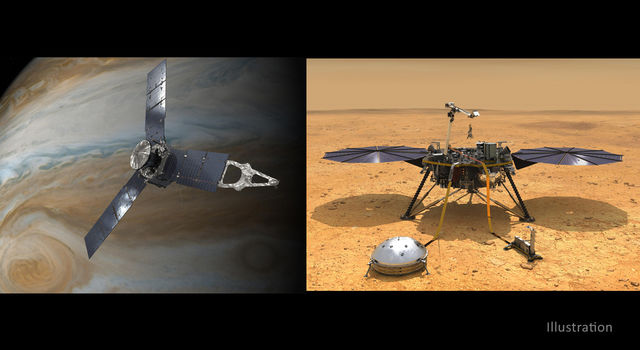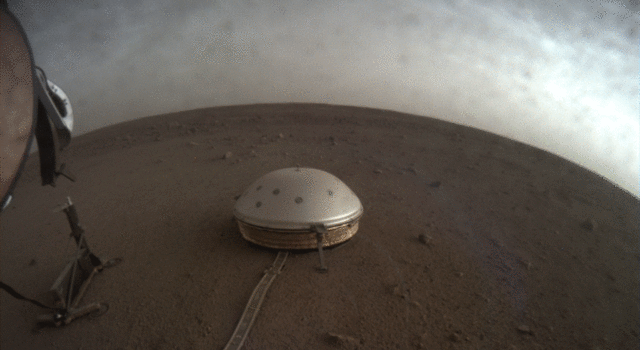Blogs | Dawn Journal | October 6, 2010
The Power of the Solar Arrays
Recently, one of our fans on the NASAJPL Facebook page asked a good question about the efficiency of solar arrays on the Dawn and Rosetta spacecraft.
"A question about Dr. Marc D. Rayman's comment in his Dawn journal, saying that 'its tremendous solar arrays [are] the most powerful ever used on an interplanetary mission.' Is that really true? According to JPL's Dawn website, the solar arrays have a total span of 19.7 meters. By comparison, each of Rosetta's two arrays is 14 meters in length (28m total). Are Dawn's arrays so much more efficient? Thanks."
Here's an answer from Dawn Chief Engineer Marc Rayman:
Yes, this is really true. Dawn's solar arrays, although smaller than Rosetta's, could indeed produce more power because they are more efficient. Fortunately, it is not a competition! Both missions seek fascinating new insights into the complex history and character of the solar system as they take all of us on adventures to exotic destinations. To overcome some of the daunting challenges of traveling moderately far from the sun, engineers on each mission have turned to powerful solar arrays.
Rosetta is a fabulous mission, promising exciting results from comet Churyumov-Gerasimenko. It is with the greatest enthusiasm that I look forward to the astonishing discoveries that await its rendezvous with this solar system relict.
The spacecraft carries the largest solar arrays ever flown on an interplanetary mission. The two 14-meter (47-foot) arrays project in opposite directions from the main spacecraft itself, creating a structure about 32 meters (105 feet) tip-to-tip, and the total area of solar cells is 53 square meters (573 square feet). Composed of silicon, these cells could have produced somewhat in excess of seven kilowatts when at Earth's distance from the sun. Of course, Rosetta did not need that much power, but as it travels into the depths of space, every watt will be precious. When the spacecraft is more than five times Earth's distance from the sun and the light from our star is much weaker, the giant arrays still will generate 400 watts, just enough to keep the probe operating. (Rosetta will arc out to that distance on its way to the comet, but it will be closer to the sun, and hence able to produce more power, when it arrives and conducts its investigations of this mysterious body).
Dawn's solar arrays, while the largest used on a NASA interplanetary mission, are smaller than Rosetta's. This bird's wingspan is about 20 meters (65 feet), and the solar arrays, each more than eight meters (27 feet) in length, have a total of about 32 square meters (341 square feet) to capture sunlight. The panels are populated with advanced cells composed of three different materials that work together to convert a larger percentage of the incident light into electrical power. The combination of indium gallium phosphide, indium gallium arsenide, and germanium makes these cells so much more efficient that despite the smaller collecting area, together they produce higher power under the same conditions. These arrays could have generated more than 10 kilowatts at Earth's distance from the sun. Dawn not only did not need such tremendous power, but like Rosetta, it was not even capable of using it all. But it too ventures far from home to remote locations where sunlight is less abundant.
Dawn's ambitious mission to orbit the two most massive residents of the asteroid belt, Vesta and Ceres, would be quite impossible without its use of ion propulsion. The key to ion propulsion's extraordinary capability is its conversion of electrical power into thrust, so Dawn carries such powerful arrays to ensure that even when exploring dwarf planet Ceres at three times Earth's distance from the sun, it can produce sufficient power to thrust and operate all other systems. I describe more about the importance of power to the mission in my Dawn Journal of July 27, 2008.
I appreciate your interest in Dawn, and I hope you will continue to join us as we travel to two of the last unexplored worlds in the inner solar system. In only 10 months, Dawn will become the first spacecraft ever to orbit a resident of the main asteroid belt as it begins its exploration of protoplanet Vesta, and to put it quite simply, this is going to be really cool!
Join the Facebook conversation at http://www.facebook.com/NASAJPL.
TAGS:DAWN, CERES, VESTA, MISSION, SPACECRAFT, ANNIVERSARY, SOLAR SYSTEM, DWARF PLANETS







